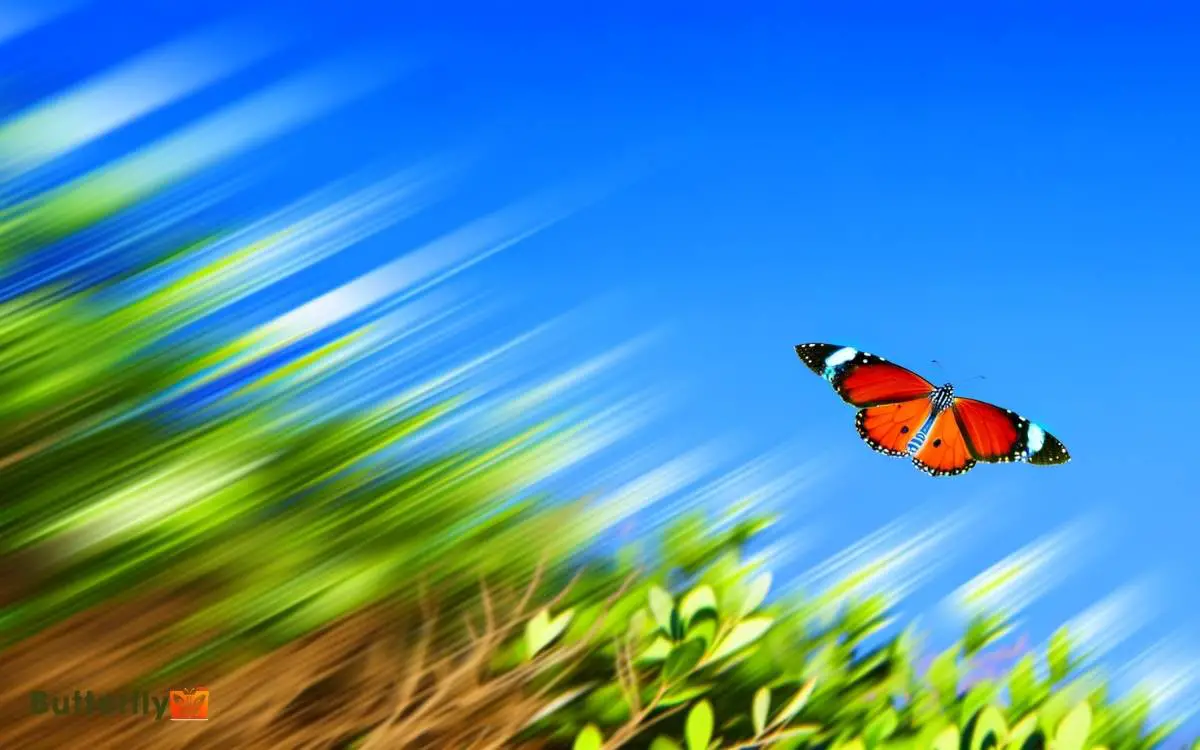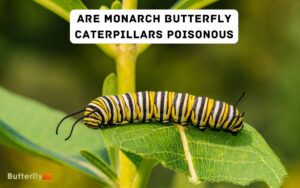How Fast Can a Monarch Butterfly Fly? 12 miles per hour!
You might wonder how fast a monarch butterfly can fly. Monarchs can achieve speeds between 5 to 12 miles per hour. Their muscular and wing structure guarantees efficient flight, allowing them to glide and conserve energy.
Factors like wind conditions, temperature, and wing morphology influence their speed. Energy reserves are essential, particularly for their lengthy migratory journeys.
Compared to other butterflies, monarchs are moderate flyers; the tiger swallowtail outpaces them at 15 miles per hour.
Despite facing migratory challenges like adverse weather and predators, their flight efficiency is important for survival.
Discover more about their intriguing journey and adaptations.

Key Takeaways
Average Flight Speed
On average, a monarch butterfly can fly at speeds of approximately 5 to 12 miles per hour. You’ll find this range indicative of their capability to cover significant distances during migration.
Monarchs possess a unique muscular and wing structure enabling efficient flight. Their flight speed isn’t just a function of wing flapping but also glide phases, reducing energy expenditure.
This adaptive strategy allows them to traverse thousands of miles between their breeding grounds in North America and wintering sites in Mexico.
Understanding their average flight speed provides critical insights into their migratory patterns, energy requirements, and overall survival strategies.
By maintaining this speed, monarchs optimize their journey for maximum efficiency and minimal fatigue, ensuring they reach their destination successfully.
Factors Affecting Speed
Examining the factors that affect a monarch butterfly’s speed reveals how environmental conditions, physiological traits, and behavioral strategies interplay to influence their flight dynamics.
You need to take into account several critical elements:
- Wind conditions: Tailwinds can boost speed, while headwinds slow them down.
- Temperature: Ideal flight occurs in warmer temperatures, enhancing muscle efficiency.
- Wing morphology: Larger wings can increase lift, aiding in sustained flight and speed.
- Energy reserves: Sufficient fat stores are essential for long-distance travel without frequent stops.
Each of these factors plays a significant role in determining how fast a monarch butterfly can fly.
Migratory Challenges
You’ll need to analyze how weather conditions critically influence the Monarch butterfly’s migration patterns, often causing delays or forcing route changes.
Additionally, you’ll explore how predators and threats, such as birds and habitat loss, pose significant risks during their long journey.
Understanding these challenges is essential for comprehending the complexity of their migratory behavior and survival strategies.
Weather Impact on Migration
Adverse weather conditions, such as strong winds and extreme temperatures, greatly challenge the migratory journey of monarch butterflies. When you’re observing their migration, you’ll notice how these factors can drastically affect their progress.
Monarchs rely on favorable wind currents to conserve energy, but strong headwinds can cause significant delays and increased energy expenditure.
Extreme temperatures can also be detrimental, either by slowing their metabolism in cold weather or causing overheating in hot conditions.
Consider the following impacts:
- Strong headwinds: Increased energy consumption.
- Extreme cold: Reduced metabolic rate, leading to slower migration.
- High temperatures: Risk of dehydration and overheating.
- Sudden storms: Disruption of flight paths and potential physical harm.
Understanding these weather impacts is crucial for comprehending the complexities of monarch butterfly migration.
Predators and Threats
Monarch butterflies face numerous predators and threats during their migration, including birds, insects, and human-induced habitat destruction.
Predatory birds like orioles and grosbeaks target them, while parasitic insects such as tachinid flies pose significant risks.
Additionally, deforestation and pesticide use severely impact their survival rates. Understanding these challenges is essential for conservation efforts.
| Predator/Threat | Impact | Mitigation Strategy |
|---|---|---|
| Orioles and Grosbeaks | Predation | Habitat protection |
| Tachinid Flies | Parasitism | Biological control |
| Deforestation | Habitat loss | Reforestation initiatives |
| Pesticides | Toxic exposure | Organic farming practices |
| Climate Change | Altered migratory patterns | Climate action policies |
Addressing these factors holistically can enhance monarch survival during their arduous journey.
Comparing Speeds
When comparing the flight speeds of various butterfly species, it’s important to note that the monarch butterfly can reach speeds of up to 12 miles per hour. This velocity is relatively moderate when juxtaposed with other species.
For instance, the painted lady butterfly can fly at approximately 10 miles per hour, while the tiger swallowtail achieves around 15 miles per hour.
The speed variations are influenced by several factors:
- Wing morphology: Different wing shapes and sizes contribute to aerodynamic efficiency.
- Muscle strength: Stronger flight muscles enable faster, more sustained flight.
- Environmental conditions: Wind, temperature, and humidity impact flight performance.
- Behavioral patterns: Migratory species often develop greater flight speeds for long-distance travel.
Understanding these factors helps you appreciate the monarch’s unique flight capabilities.
Flight Mechanics
To understand how monarch butterflies achieve flight, let’s explore the intricate mechanics involving wing structure, muscle coordination, and aerodynamic principles.
Monarch wings are composed of chitin, a lightweight yet durable material. Their flight muscles, primarily the dorsoventral and dorso-longitudinal muscles, contract and expand in a coordinated manner, enabling wing flapping.
| Aspect | Function | Detail |
|---|---|---|
| Wing Structure | Provides lift and thrust | Chitin-based, flexible, and robust |
| Muscle Coordination | Facilitates wing movement | Dorsoventral and dorso-longitudinal muscle groups |
| Aerodynamics | Optimizes flight efficiency | Wing shape enhances lift and reduces drag |
Seasonal Variations
During different seasons, the flight patterns and behaviors of monarch butterflies exhibit significant adaptations.
In spring and summer, monarchs optimize their flight for reproduction and feeding. You’ll notice they fly shorter distances, focusing on finding milkweed and nectar sources.
Conversely, during autumn migration, their flight speed and endurance increase dramatically as they travel thousands of miles to overwintering sites.
Seasonal changes in temperature and daylight trigger these adaptations, influencing:
- Flight speed and distance
- Energy consumption and storage
- Navigational strategies
- Behavioral responses to environmental cues
Understanding these variations allows you to appreciate how monarchs have evolved to maximize survival and reproductive success throughout the year. Each adaptation is a critical component of their life cycle strategy.
Conservation Impact
Conservation efforts for monarch butterflies greatly influence their populations by addressing habitat loss, pesticide use, and climate change.
You can enhance their habitats by planting native milkweed, an essential larval host plant. Reducing pesticide use mitigates toxic exposure, benefiting not only monarchs but also other pollinators.
Climate change poses a significant threat by altering migration patterns and breeding cycles. You should support initiatives that reduce greenhouse gas emissions and promote sustainable agricultural practices.
Participation in citizen science programs also provides critical data for tracking monarch populations and migration routes.
Conclusion
In summary, you’ve seen how a monarch butterfly’s flight speed, typically around 5.5 miles per hour, is influenced by factors like wind and temperature. Migratory journeys pose significant challenges, yet these resilient insects navigate with remarkable precision.
Comparing speeds with other insects, monarchs are neither the fastest nor the slowest. Their flight mechanics, akin to a well-oiled machine, adapt with seasonal variations.
Conservation efforts remain vital to guarantee these delicate aviators continue their epic migrations.






